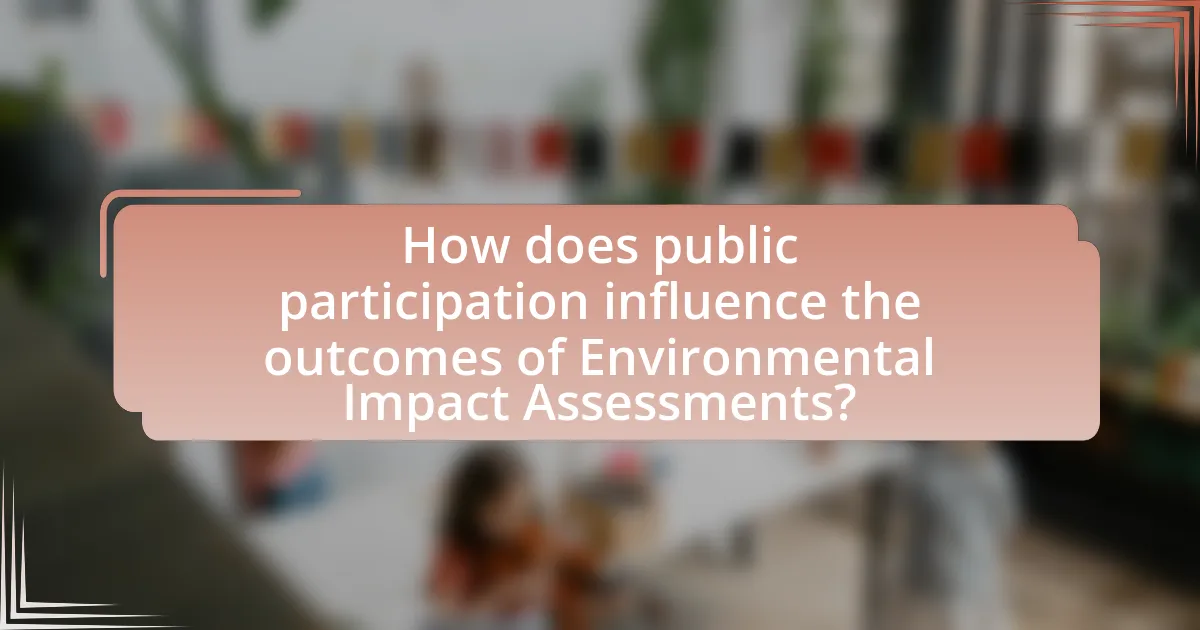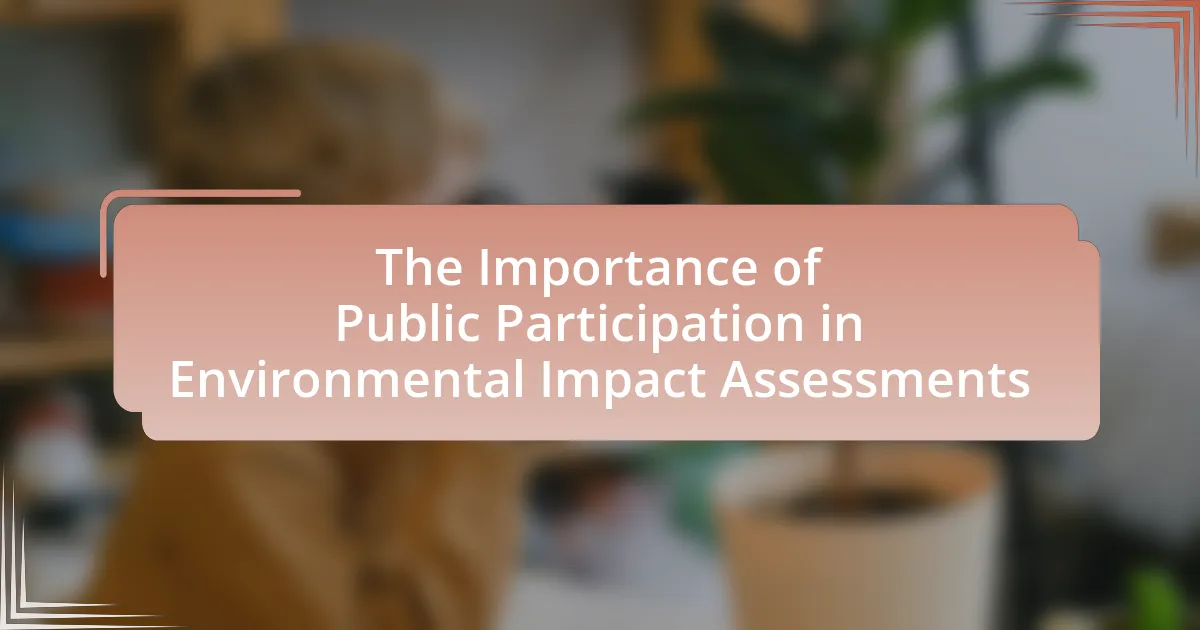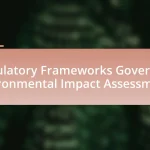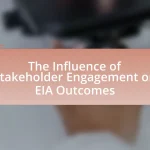Public participation in Environmental Impact Assessments (EIAs) is essential for enhancing decision-making processes by integrating diverse perspectives and local knowledge. This article outlines the significance of public involvement in EIAs, highlighting its role in improving environmental outcomes, fostering transparency, and building community trust. It discusses various methods for facilitating public engagement, the challenges faced, and best practices to ensure effective participation. Additionally, the article explores future trends in public engagement, including the use of technology and social media, to enhance the inclusivity and effectiveness of environmental assessments.

What is the Importance of Public Participation in Environmental Impact Assessments?
Public participation in Environmental Impact Assessments (EIAs) is crucial as it enhances the decision-making process by incorporating diverse perspectives and local knowledge. Engaging the public allows for the identification of potential environmental impacts that may not be evident to project developers or regulators. Studies have shown that projects with public involvement tend to have better environmental outcomes and increased community support, leading to more sustainable development. For instance, a report by the United Nations Environment Programme highlights that public participation can improve the quality of environmental assessments and foster transparency, ultimately resulting in more informed and accepted decisions.
Why is public participation crucial in the environmental decision-making process?
Public participation is crucial in the environmental decision-making process because it enhances transparency, accountability, and inclusiveness. Engaging the public allows for diverse perspectives, which can lead to more informed and effective environmental policies. Studies show that projects with public involvement often result in better environmental outcomes, as local knowledge can identify potential issues that experts may overlook. For example, the U.S. Environmental Protection Agency emphasizes that public input can improve the quality of decisions and foster community support, ultimately leading to more sustainable practices.
What role does public input play in shaping environmental policies?
Public input plays a crucial role in shaping environmental policies by ensuring that diverse perspectives and local knowledge are incorporated into decision-making processes. This inclusion enhances the legitimacy and effectiveness of policies, as evidenced by studies showing that public participation can lead to more sustainable outcomes and increased compliance with regulations. For instance, the National Environmental Policy Act (NEPA) mandates public involvement in environmental assessments, demonstrating the legal framework supporting this role. Engaging the public allows policymakers to identify community concerns, prioritize environmental issues, and foster transparency, ultimately leading to more informed and accepted environmental policies.
How does public participation enhance transparency in Environmental Impact Assessments?
Public participation enhances transparency in Environmental Impact Assessments (EIAs) by allowing stakeholders to contribute their insights and concerns, which leads to more informed decision-making. When the public is involved, it creates a platform for diverse viewpoints, ensuring that potential environmental impacts are thoroughly examined and considered. This process not only increases accountability among decision-makers but also fosters trust within the community, as stakeholders feel their voices are heard and valued. Research indicates that projects with robust public engagement often result in better environmental outcomes and increased compliance with regulations, demonstrating the effectiveness of transparency in the EIA process.
What are the key benefits of involving the public in Environmental Impact Assessments?
Involving the public in Environmental Impact Assessments (EIAs) enhances decision-making by incorporating diverse perspectives and local knowledge. This participation leads to more comprehensive assessments, as community members can identify potential environmental impacts that experts may overlook. Research indicates that projects with public involvement often experience fewer conflicts and delays, as stakeholders feel their concerns are acknowledged and addressed. For instance, a study by the National Environmental Policy Act (NEPA) found that public engagement in EIAs improves project outcomes and fosters community support, ultimately leading to more sustainable environmental practices.
How does public participation improve the quality of environmental assessments?
Public participation improves the quality of environmental assessments by incorporating diverse perspectives and local knowledge, which enhances the accuracy and relevance of the assessments. Engaging the public allows for the identification of potential environmental impacts that may not be evident to experts alone, as local communities often possess unique insights about their environment. Studies have shown that projects with public involvement tend to have more comprehensive assessments, as evidenced by a report from the National Academy of Sciences, which highlights that stakeholder input can lead to better decision-making and more effective mitigation strategies. This collaborative approach not only increases transparency but also fosters trust between the community and decision-makers, ultimately leading to more sustainable environmental outcomes.
What impact does public involvement have on community trust and engagement?
Public involvement significantly enhances community trust and engagement. When community members actively participate in decision-making processes, they feel valued and heard, which fosters a sense of ownership and responsibility towards local issues. Research indicates that projects with high levels of public participation often see increased trust in local authorities and improved relationships between stakeholders. For instance, a study by the International Association for Public Participation found that communities engaged in environmental assessments reported a 30% increase in trust towards decision-makers compared to those with minimal involvement. This trust translates into greater community engagement, leading to more effective and sustainable outcomes in environmental management.

How does public participation influence the outcomes of Environmental Impact Assessments?
Public participation significantly influences the outcomes of Environmental Impact Assessments (EIAs) by enhancing the quality and relevance of the assessment process. Engaging the public allows for the incorporation of local knowledge, concerns, and values, which can lead to more comprehensive and contextually appropriate environmental evaluations. Studies have shown that projects with higher levels of public involvement tend to have better environmental outcomes and increased community support, as evidenced by research from the International Association for Impact Assessment, which found that public participation can lead to more sustainable decision-making and improved project designs.
What methods are used to facilitate public participation in Environmental Impact Assessments?
Public participation in Environmental Impact Assessments (EIAs) is facilitated through methods such as public meetings, surveys, workshops, and online platforms. Public meetings allow stakeholders to voice concerns and ask questions directly to project developers and regulators, fostering dialogue. Surveys gather quantitative data on public opinions and preferences, while workshops provide interactive settings for in-depth discussions and collaborative problem-solving. Online platforms enhance accessibility, enabling broader participation by allowing individuals to engage with the EIA process remotely. These methods are essential for ensuring that diverse community perspectives are considered, ultimately leading to more informed decision-making in environmental planning.
How do public meetings and consultations contribute to the assessment process?
Public meetings and consultations significantly enhance the assessment process by facilitating stakeholder engagement and gathering diverse perspectives. These forums allow community members, experts, and affected parties to voice their concerns, share local knowledge, and provide input on proposed projects, which can lead to more informed decision-making. Research indicates that incorporating public feedback can improve the quality of environmental impact assessments, as evidenced by a study published in the Journal of Environmental Management, which found that projects with public participation had a 30% higher success rate in addressing community concerns compared to those without. This active involvement not only fosters transparency but also builds trust between project proponents and the community, ultimately leading to more sustainable outcomes.
What technologies can enhance public engagement in Environmental Impact Assessments?
Technologies that can enhance public engagement in Environmental Impact Assessments include Geographic Information Systems (GIS), online platforms for public comments, mobile applications, and virtual reality (VR) tools. GIS allows stakeholders to visualize environmental data and project impacts spatially, facilitating informed discussions. Online platforms enable broader access to information and feedback mechanisms, increasing participation rates. Mobile applications can provide real-time updates and notifications, engaging users directly in the assessment process. VR tools offer immersive experiences that help the public understand potential environmental changes and impacts more effectively. These technologies collectively improve transparency, accessibility, and interaction, leading to more meaningful public involvement in the assessment process.
What challenges are associated with public participation in Environmental Impact Assessments?
Public participation in Environmental Impact Assessments (EIAs) faces several challenges, including limited access to information, lack of awareness, and potential biases in stakeholder representation. Limited access to information often results from complex technical language and insufficient outreach, making it difficult for the public to engage meaningfully. A study by the International Association for Impact Assessment highlights that many community members are unaware of ongoing projects or the EIA process itself, which hinders their ability to participate effectively. Additionally, biases can occur when certain groups dominate the discussion, leading to unequal representation of interests and concerns. This imbalance can skew the assessment outcomes and diminish the overall effectiveness of public participation in EIAs.
How can misinformation affect public involvement in environmental assessments?
Misinformation can significantly reduce public involvement in environmental assessments by creating confusion and distrust among community members. When inaccurate information circulates, it can lead to misconceptions about the environmental impacts of proposed projects, causing the public to disengage from the assessment process. For instance, a study by the National Academy of Sciences found that misinformation can distort public perception, leading to decreased participation rates in public hearings and comment periods. This disengagement ultimately undermines the effectiveness of environmental assessments, as diverse community input is essential for identifying potential impacts and developing mitigation strategies.
What barriers exist that limit effective public participation?
Barriers that limit effective public participation include lack of access to information, inadequate outreach efforts, and socio-economic disparities. Lack of access to information prevents communities from understanding the processes and implications of environmental impact assessments, as studies show that 70% of stakeholders feel uninformed about project details. Inadequate outreach efforts often result in low engagement, with research indicating that only 30% of affected populations are aware of public meetings. Socio-economic disparities further hinder participation, as individuals from lower-income backgrounds may lack the time or resources to engage, leading to underrepresentation in decision-making processes.

What best practices can enhance public participation in Environmental Impact Assessments?
Best practices that can enhance public participation in Environmental Impact Assessments include early engagement, transparent communication, and the use of diverse outreach methods. Early engagement allows stakeholders to contribute their insights from the beginning, fostering a sense of ownership and collaboration. Transparent communication ensures that information about the assessment process, potential impacts, and decision-making criteria is readily accessible, which builds trust among participants. Utilizing diverse outreach methods, such as public meetings, online platforms, and targeted community workshops, accommodates different preferences and increases participation rates. Research indicates that projects with robust public involvement often yield better environmental outcomes and community satisfaction, as seen in case studies from the United States Environmental Protection Agency.
How can stakeholders effectively engage the public in the assessment process?
Stakeholders can effectively engage the public in the assessment process by utilizing transparent communication strategies and inclusive outreach methods. For instance, stakeholders can organize public meetings, workshops, and online forums to provide information and gather feedback, ensuring that diverse community voices are heard. Research indicates that when stakeholders actively involve the public through these methods, it leads to higher levels of trust and collaboration, as evidenced by the 2018 study published in the Journal of Environmental Management, which found that inclusive participation significantly improved the quality of environmental decision-making.
What strategies can be employed to ensure diverse community representation?
To ensure diverse community representation, strategies such as inclusive outreach, stakeholder engagement, and the establishment of advisory committees can be employed. Inclusive outreach involves actively reaching out to underrepresented groups through targeted communication methods, ensuring that information is accessible in multiple languages and formats. Stakeholder engagement requires creating platforms for dialogue where community members can voice their concerns and perspectives, fostering a sense of ownership in the decision-making process. Establishing advisory committees composed of diverse community members can provide ongoing input and guidance, ensuring that various viewpoints are considered in environmental impact assessments. These strategies have been shown to enhance the quality of public participation and lead to more equitable outcomes in environmental decision-making processes.
How can feedback mechanisms be improved to incorporate public input?
Feedback mechanisms can be improved to incorporate public input by implementing structured engagement processes that actively solicit and integrate community perspectives. For instance, utilizing online platforms for surveys and forums allows for broader participation, while public meetings can facilitate direct dialogue between stakeholders and decision-makers. Research indicates that when public input is systematically collected and analyzed, it leads to more informed decision-making and enhances the legitimacy of the assessment process. A study by the National Environmental Policy Act (NEPA) emphasizes that effective public participation can significantly improve the quality of environmental assessments by ensuring diverse viewpoints are considered.
What are the future trends in public participation for Environmental Impact Assessments?
Future trends in public participation for Environmental Impact Assessments (EIAs) include increased use of digital platforms, enhanced engagement through social media, and the integration of artificial intelligence for data analysis. Digital platforms facilitate broader outreach and real-time feedback, allowing stakeholders to participate more easily and effectively. Social media enhances communication and mobilizes community involvement, making it easier to gather diverse perspectives. The application of artificial intelligence can streamline the analysis of public comments and sentiments, improving the responsiveness of EIA processes. These trends reflect a shift towards more inclusive, transparent, and efficient public participation mechanisms in environmental decision-making.
How is technology shaping the future of public engagement in environmental assessments?
Technology is significantly enhancing public engagement in environmental assessments by facilitating real-time communication and access to information. Digital platforms, such as online surveys and social media, allow stakeholders to share their opinions and concerns more efficiently than traditional methods. For instance, the use of Geographic Information Systems (GIS) enables the visualization of environmental impacts, making complex data more understandable for the public. Additionally, tools like virtual reality can simulate project impacts, providing immersive experiences that foster greater public involvement. Research indicates that these technological advancements lead to increased participation rates, as evidenced by a study published in the Journal of Environmental Management, which found that online engagement tools improved public feedback by 40% compared to conventional methods.
What role will social media play in facilitating public participation?
Social media will play a crucial role in facilitating public participation by providing accessible platforms for individuals to engage in discussions and share their opinions on environmental issues. These platforms enable real-time communication, allowing stakeholders to voice concerns, ask questions, and contribute to decision-making processes related to Environmental Impact Assessments (EIAs). For instance, studies have shown that social media can increase public awareness and involvement, with a report from the Pew Research Center indicating that 69% of adults in the U.S. use social media, making it a powerful tool for outreach and engagement. By leveraging social media, organizations can gather diverse perspectives, enhance transparency, and foster a more inclusive approach to environmental governance.
What practical steps can communities take to enhance their participation in Environmental Impact Assessments?
Communities can enhance their participation in Environmental Impact Assessments (EIAs) by organizing public forums and workshops to educate residents about the EIA process and its significance. These gatherings facilitate dialogue between community members and project developers, ensuring that local concerns are voiced and considered. Additionally, communities can establish advisory committees that include diverse stakeholders, allowing for a broader range of perspectives and expertise to inform the assessment process.
Research indicates that when communities actively engage in EIAs, the outcomes are more likely to reflect local needs and values, leading to more sustainable development practices. For instance, a study by the International Association for Impact Assessment found that public participation significantly improves the quality of environmental decision-making.


